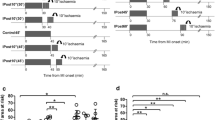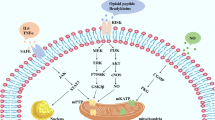Abstract
The mechanism for limb ischemic precondition (RLIPC)-induced suppression of reperfusion arrhythmia remains unknown. The purpose of this study was to examine the roles of the pro-survival reperfusion injury salvage kinase (RISK) and survivor activating factor enhancement (SAFE) pathways in this RLIPC-mediated antiarrhythmic activity. Male Sprague Dawley rats were assigned to sham-operated, control, or RLIPC groups. All rats except for the sham rats had 5 min of left main coronary artery occlusion with another 20 min of reperfusion. RLIPC was initiated by four cycles of limb ischemia (5 min) and reperfusion (5 min) on the bilateral femoral arteries. Hearts in every group were taken for protein phosphorylation analysis. RLIPC ameliorated reperfusion-induced arrhythmogenesis and reduced the incidence of sudden cardiac death during the entire 20-min reperfusion period (66.7% of control rats had SCD vs. only 16.7% of RLIPC-treated rats). RLIPC enhances ventricular ERK1/2 phosphorylation after reperfusion. RLIPC-induced antiarrhythmic action and ERK1/2 phosphorylation are abolished in the presence of the ERK1/2 inhibitor U0126. Limb ischemic preconditioning protects the heart against myocardial reperfusion injury-induced lethal arrhythmia. These beneficial effects may involve the activation of ERK1/2 in the RISK signaling pathway.







Similar content being viewed by others
Data availability
The data that support the findings of this study are available from the corresponding author upon reasonable request.
References
Ahmed RM, el Mohamed HA, Ashraf M, Maithili S, Nabil F, Rami R, Mohamed TI (2013) Effect of remote ischemic preconditioning on serum troponin T level following elective percutaneous coronary intervention. Catheter and cardiovasc interv : Off J Soc Card Angiography Interv 82:E647-653. https://doi.org/10.1002/ccd.24825
Banerjee A, Locke-Winter C, Rogers KB, Mitchell MB, Brew EC, Cairns CB, Bensard DD, Harken AH (1993) Preconditioning against myocardial dysfunction after ischemia and reperfusion by an alpha 1-adrenergic mechanism. Circ Res 73:656–670. https://doi.org/10.1161/01.res.73.4.656
Cai Z, Luo W, Zhan H, Semenza GL (2013) Hypoxia-inducible factor 1 is required for remote ischemic preconditioning of the heart. Proc Natl Acad Sci USA 110:17462–17467. https://doi.org/10.1073/pnas.1317158110
Chen Z, Luo H, Zhuang M, Cai L, Su C, Lei Y, Zou J (2011) Effects of ischemic preconditioning on ischemia/reperfusion-induced arrhythmias by upregulatation of connexin 43 expression. J Cardiothorac Surg 6:80. https://doi.org/10.1186/1749-8090-6-80
Cho YJ, Kim WH (2019) Perioperative cardioprotection by remote ischemic conditioning. Int J Mol Sci 20. https://doi.org/10.3390/ijms20194839
Daugherty A, Frayn KN, Redfern WS, Woodward B (1986) The role of catecholamines in the production of ischaemia-induced ventricular arrhythmias in the rat in vivo and in vitro. Br J Pharmacol 87:265–277. https://doi.org/10.1111/j.1476-5381.1986.tb10180.x
Davies WR, Brown AJ, Watson W, McCormick LM, West NE, Dutka DP, Hoole SP (2013) Remote ischemic preconditioning improves outcome at 6 years after elective percutaneous coronary intervention: the CRISP stent trial long-term follow-up. Circ Cardiovasc Interv 6:246–251. https://doi.org/10.1161/CIRCINTERVENTIONS.112.000184
Donato M, Bin EP, V DA, Gelpi RJ, (2021) Myocardial remote ischemic preconditioning: from cell biology to clinical application. Mol Cell Biochem 476:3857–3867. https://doi.org/10.1007/s11010-021-04192-4
Dow J, Bhandari A, Simkhovich BZ, Hale SL, Kloner RA (2012) The effect of acute versus delayed remote ischemic preconditioning on reperfusion induced ventricular arrhythmias. J Cardiovasc Electrophysiol 23:1374–1383. https://doi.org/10.1111/j.1540-8167.2012.02397.x
Eisen A, Fisman EZ, Rubenfire M, Freimark D, McKechnie R, Tenenbaum A, Motro M, Adler Y (2004) Ischemic preconditioning: nearly two decades of research. A comprehensive review. Atherosclerosis 172:201–210. https://doi.org/10.1016/S0021-9150(03)00238-7
Hadebe N, Cour M, Lecour S (2018) The SAFE pathway for cardioprotection: is this a promising target? Basic Res Cardiol 113:9. https://doi.org/10.1007/s00395-018-0670-5
Hausenloy DJ, Yellon DM (2008) Remote ischaemic preconditioning: underlying mechanisms and clinical application. Cardiovasc Res 79:377–386. https://doi.org/10.1093/cvr/cvn114
Hausenloy DJ, Yellon DM (2016) Ischaemic conditioning and reperfusion injury. Nat Rev Cardiol 13:193–209. https://doi.org/10.1038/nrcardio.2016.5
Hoole SP, Heck PM, Sharples L, Khan SN, Duehmke R, Densem CG, Clarke SC, Shapiro LM, Schofield PM, O’Sullivan M, Dutka DP (2009) Cardiac Remote Ischemic Preconditioning in Coronary Stenting (CRISP Stent) Study: a prospective, randomized control trial. Circulation 119:820–827. https://doi.org/10.1161/CIRCULATIONAHA.108.809723
Hu Z, Chen M, Zhang P, Liu J, Abbott GW (2017) Remote ischemic preconditioning differentially attenuates post-ischemic cardiac arrhythmia in streptozotocin-induced diabetic versus nondiabetic rats. Cardiovasc Diabetol 16:57. https://doi.org/10.1186/s12933-017-0537-3
Hu Z, Hu S, Yang S, Chen M, Zhang P, Liu J, Abbott GW (2016) Remote liver ischemic preconditioning protects against sudden cardiac death via an ERK/GSK-3beta-dependent mechanism. PLoS ONE 11:e0165123. https://doi.org/10.1371/journal.pone.0165123
Hu Z, Ju F, Du L, Abbott GW (2021) Empagliflozin protects the heart against ischemia/reperfusion-induced sudden cardiac death. Cardiovasc Diabetol 20:199. https://doi.org/10.1186/s12933-021-01392-6
Hu Z, Liu Q, Yan Z, Wang Q, Liu J (2022) Protective effect of remote ischemic postconditioning in rat testes after testicular torsion/detorsion. Andrology. https://doi.org/10.1111/andr.13184
Kerendi F, Kin H, Halkos ME, Jiang R, Zatta AJ, Zhao ZQ, Guyton RA, Vinten-Johansen J (2005) Remote postconditioning. Brief renal ischemia and reperfusion applied before coronary artery reperfusion reduces myocardial infarct size via endogenous activation of adenosine receptors. Basic Res Cardiol 100:404–412. https://doi.org/10.1007/s00395-005-0539-2
Kharbanda RK, Mortensen UM, White PA, Kristiansen SB, Schmidt MR, Hoschtitzky JA, Vogel M, Sorensen K, Redington AN, MacAllister R (2002) Transient limb ischemia induces remote ischemic preconditioning in vivo. Circulation 106:2881–2883. https://doi.org/10.1161/01.cir.0000043806.51912.9b
Kristiansen SB, Henning O, Kharbanda RK, Nielsen-Kudsk JE, Schmidt MR, Redington AN, Nielsen TT, Botker HE (2005) Remote preconditioning reduces ischemic injury in the explanted heart by a KATP channel-dependent mechanism. Am J Physiol Heart Circ Physiol 288:H1252-1256. https://doi.org/10.1152/ajpheart.00207.2004
Lecour S (2009) Activation of the protective survivor activating factor enhancement (SAFE) pathway against reperfusion injury: does it go beyond the RISK pathway? J Mol Cell Cardiol 47:32–40. https://doi.org/10.1016/j.yjmcc.2009.03.019
Li SJ, Wu YN, Kang Y, Yin YQ, Gao WZ, Liu YX, Lou JS (2010) Noninvasive limb ischemic preconditioning protects against myocardial I/R injury in rats. J Surg Res 164:162–168. https://doi.org/10.1016/j.jss.2009.03.017
Lim SY, Hausenloy DJ (2012) Remote ischemic conditioning: from bench to bedside. Front Physiol 3:27. https://doi.org/10.3389/fphys.2012.00027
Liu Z, Cui L, Wang Y, Guo Y (2006) Cardiac troponin I and ventricular arrhythmia in patients with chronic heart failure. Eur J Clin Invest 36:466–472. https://doi.org/10.1111/j.1365-2362.2006.01655.x
Luo N, Liu J, Chen Y, Li H, Hu Z, Abbott GW (2018) Remote ischemic preconditioning STAT3-dependently ameliorates pulmonary ischemia/reperfusion injury. PLoS ONE 13:e0196186. https://doi.org/10.1371/journal.pone.0196186
Murry CE, Jennings RB, Reimer KA (1986) Preconditioning with ischemia: a delay of lethal cell injury in ischemic myocardium. Circulation 74:1124–1136. https://doi.org/10.1161/01.cir.74.5.1124
Oxman T, Arad M, Klein R, Avazov N, Rabinowitz B (1997) Limb ischemia preconditions the heart against reperfusion tachyarrhythmia. Am J Physiol 273:H1707-1712. https://doi.org/10.1152/ajpheart.1997.273.4.H1707
Payne RE, Aldwinckle J, Storrow J, Kong RS, Lewis ME (2015) RIPC remains a promising technique for protection of the myocardium during open cardiac surgery: a meta-analysis and systematic review. Heart Surg Forum 18:E074-080. https://doi.org/10.1532/hsf.1251
Przyklenk K, Bauer B, Ovize M, Kloner RA, Whittaker P (1993) Regional ischemic “preconditioning” protects remote virgin myocardium from subsequent sustained coronary occlusion. Circulation 87:893–899. https://doi.org/10.1161/01.cir.87.3.893
Randhawa PK, Bali A, Jaggi AS (2015) RIPC for multiorgan salvage in clinical settings: evolution of concept, evidences and mechanisms. Eur J Pharmacol 746:317–332. https://doi.org/10.1016/j.ejphar.2014.08.016
Rossello X, Yellon DM (2016) A critical review on the translational journey of cardioprotective therapies! Int J Cardiol 220:176–184. https://doi.org/10.1016/j.ijcard.2016.06.131
Rossello X, Yellon DM (2018) The RISK pathway and beyond. Basic Res Cardiol 113:2. https://doi.org/10.1007/s00395-017-0662-x
Schmidt MR, Sloth AD, Johnsen J, Botker HE (2012) Remote ischemic conditioning: the cardiologist’s perspective. J Cardiovasc Med 13:667–674. https://doi.org/10.2459/JCM.0b013e328357bff2
Schomig A, Haass M, Richardt G (1991) Catecholamine release and arrhythmias in acute myocardial ischaemia. Eur Heart J 12(Suppl F):38–47. https://doi.org/10.1093/eurheartj/12.suppl_f.38
Skeik N, Patel DC (2007) A review of troponins in ischemic heart disease and other conditions. Int J Angiol : Off Publ Int Coll Angiol Inc 16:53–58. https://doi.org/10.1055/s-0031-1278248
Skyschally A, Gent S, Amanakis G, Schulte C, Kleinbongard P, Heusch G (2015) Across-species transfer of protection by remote ischemic preconditioning with species-specific myocardial signal transduction by reperfusion injury salvage kinase and survival activating factor enhancement pathways. Circ Res 117:279–288. https://doi.org/10.1161/CIRCRESAHA.117.306878
Tamareille S, Mateus V, Ghaboura N, Jeanneteau J, Croue A, Henrion D, Furber A, Prunier F (2011) RISK and SAFE signaling pathway interactions in remote limb ischemic perconditioning in combination with local ischemic postconditioning. Basic Res Cardiol 106:1329–1339. https://doi.org/10.1007/s00395-011-0210-z
Wang YP, Maeta H, Mizoguchi K, Suzuki T, Yamashita Y, Oe M (2002) Intestinal ischemia preconditions myocardium: role of protein kinase C and mitochondrial K(ATP) channel. Cardiovasc Res 55:576–582. https://doi.org/10.1016/s0008-6363(02)00245-6
Weselcouch EO, Baird AJ, Sleph PG, Dzwonczyk S, Murray HN, Grover GJ (1995) Endogenous catecholamines are not necessary for ischaemic preconditioning in the isolated perfused rat heart. Cardiovasc Res 29:126–132
Yang L, Wang G, Du Y, Ji B, Zheng Z (2014) Remote ischemic preconditioning reduces cardiac troponin I release in cardiac surgery: a meta-analysis. J Cardiothorac Vasc Anesth 28:682–689. https://doi.org/10.1053/j.jvca.2013.05.035
Yang S, Abbott GW, Gao WD, Liu J, Luo C, Hu Z (2017) Involvement of glycogen synthase kinase-3beta in liver ischemic conditioning induced cardioprotection against myocardial ischemia and reperfusion injury in rats. J Appl Physiol 122:1095–1105. https://doi.org/10.1152/japplphysiol.00862.2016
Funding
This work was supported by Sichuan University West China Hospital setup funding to ZH.
Author information
Authors and Affiliations
Contributions
ZH designed the study. XC, HL, ZY, and ZH performed the experiments. XC, HL, ZY, JL, and ZH conducted acquisition, analysis, or interpretation of data for the work. ZH drafted the manuscript. All the authors read, revised, and approved the final manuscript.
Corresponding author
Ethics declarations
Ethical approval and consent to participate
This study was reviewed and approved by the Institutional Animal Care and Use Committee of Sichuan University (Approval No. 2015035A).
Consent for publication
Not applicable.
Competing interests
The authors declare no competing interests.
Additional information
Publisher's note
Springer Nature remains neutral with regard to jurisdictional claims in published maps and institutional affiliations.
Rights and permissions
About this article
Cite this article
Cheng, X., Li, H., Yan, Z. et al. Ischemic limb preconditioning-induced anti-arrhythmic effect in reperfusion-induced myocardial injury: is it mediated by the RISK or SAFE pathway?. Pflugers Arch - Eur J Physiol 474, 979–991 (2022). https://doi.org/10.1007/s00424-022-02716-5
Received:
Accepted:
Published:
Issue Date:
DOI: https://doi.org/10.1007/s00424-022-02716-5




